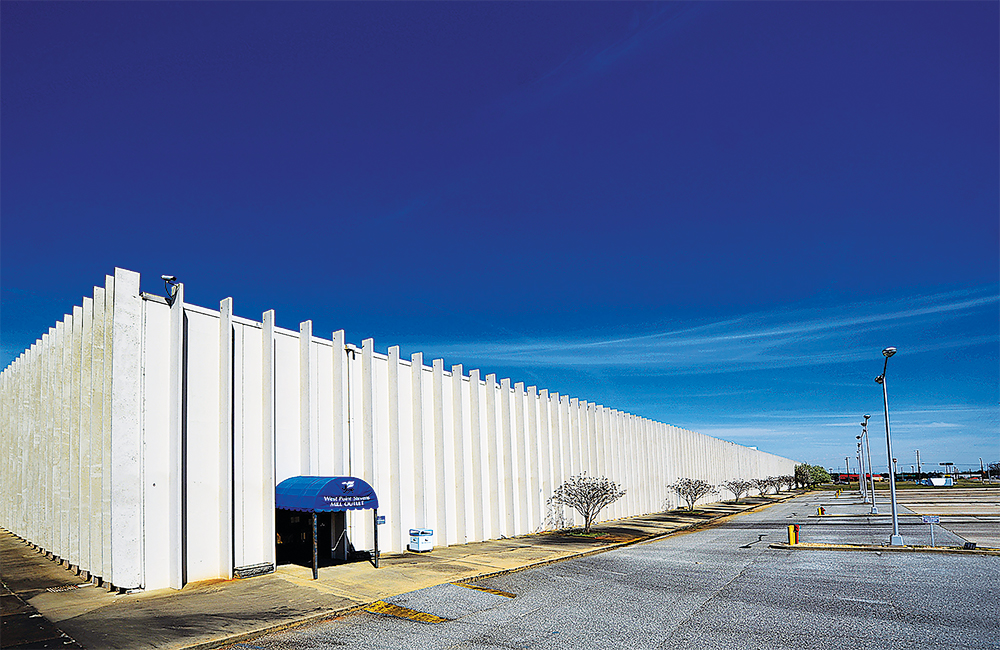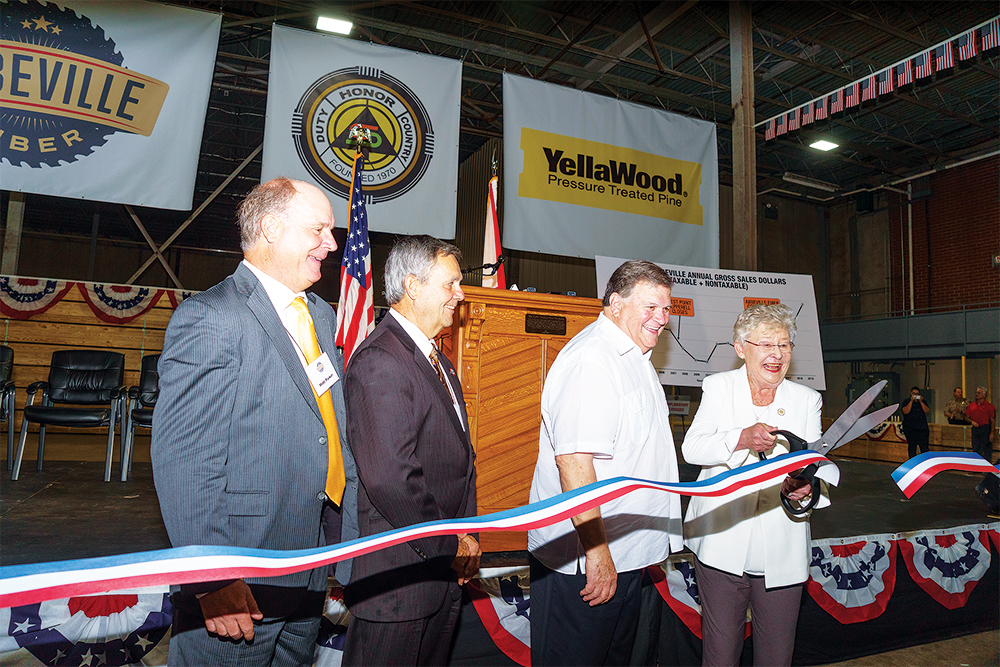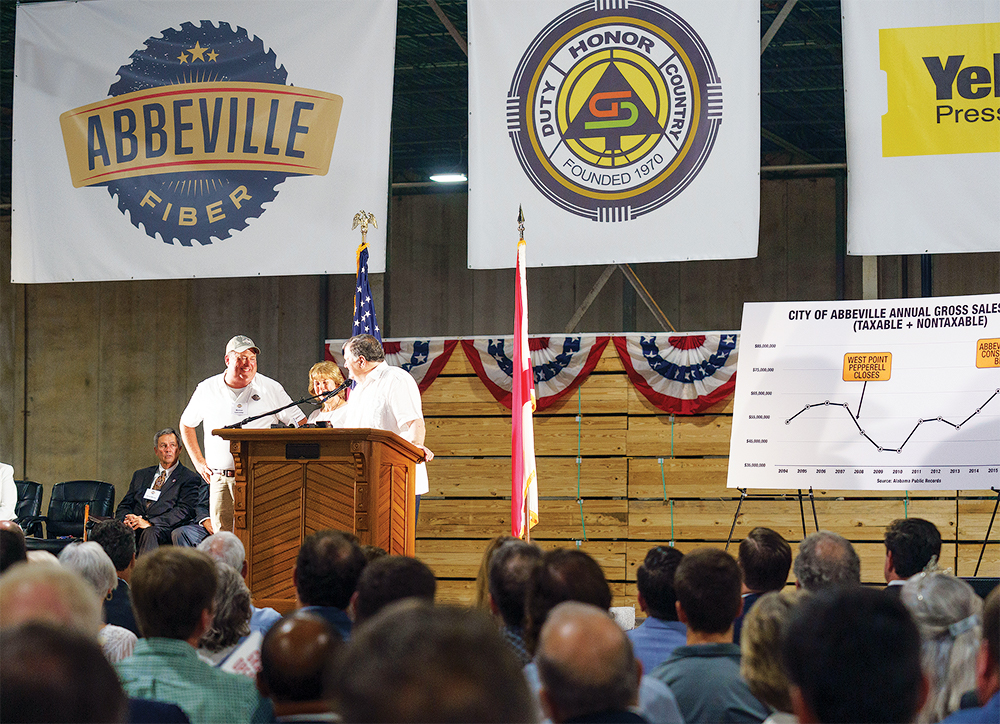By Todd Stacy, Alabama Daily News

The old WestPoint Pepperell mill in Abbeville, Ala., is a long, greyish white structure that stretches two city blocks in all directions at the corner of State Highway 27 and U.S. 431.
For many southerners, the building’s long, column-stilted concrete exterior is familiar.
Textile giant WestPoint Pepperell dotted the Alabama, Georgia, and Carolina landscape with dozens of similar-looking mills during the 1950s, 1960s and 1970s when the industry was still booming. Cotton was plentiful and the labor was relatively cheap, as was the power from hydroelectric dams in places like the Chattahoochee River Valley. And while the buildings were spartan and austere on the outside, the inside housed the beating economic heart of their communities.
But over time, a different kind of familiar sight began to set in. In the mid-2000s, WestPoint, now merged and reincorporated as WestPoint Stevens, began moving the manufacturing of many of its popular bedding brands overseas. Mills once humming with thousands of workers slowly shuttered throughout the South, and the ridge-lined exterior walls turned to empty shells, the leftover fossils of industries that once sustained families and hometowns.
Here in Abbeville, the plant where workers made bedsheets and pillowcases began to close in 2007. More than 1,400 employees were forced to find work elsewhere, not an easy task in rural Alabama, especially once the Great Recession set in.
Abbeville’s story ultimately has a happy ending, or at least they are getting there. But countless other rural Alabama towns face similar situations and few, if any, have a Jimmy Rane.
“It was a real live depression here,” said Rane, CEO of Great Southern Wood Preserving, the homegrown lumber business he has built into a major corporation.
It was Rane’s father who originally helped recruit WestPoint from New England to Henry County over spaghetti suppers with company executives in his family restaurant.
“Just imagine a community of 3,000 people losing 1,400 jobs. That affected more than the population of the entire town.”
State Rep. Dexter Grimsley, D-Abbeville, who has represented
Henry County and part of neighboring Houston County in the Alabama Legislature since 2010, said the plant closing exacerbated existing economic problems.
“It wasn’t just West Point Stevens,” Grimsley said. “Abbeville used to be a thriving town with four or five of these manufacturing type industries, but a lot of them closed up and moved away. That left us with a whole lot of needs as a community.”
Having tried unsuccessfully to re-purpose the mill, WestPoint Stevens explored selling the facility for salvage, with its inner metals broken down and sold for scrap.
Finding that unacceptable, Rane stepped in.
“I got them on the phone and said ‘you have no idea what this building means to my little town. You tear it down, and it’s the last chance we are ever going to have to bring in a big industry down here,’” Rane said. “They told me if I would pay them what the salvage company was going to pay, they’d sell it to me. I told the guy, ‘buddy, I don’t know how the hell I’m going to do that, but I’m going to do it.’”
After Rane acquired the building, a painstaking effort to redevelop the old mill and bring the jobs back began. It involved local leaders, including from Houston County, as well as state officials spanning multiple governor’s administrations.
“We’ve had to think regionally,” Grimsley said. “What’s good for Abbeville and Headland can be good for Dothan, and vice versa. I think everyone began to understand that.”
Now, more than a decade later, on a hot, rainy, late summer morning, this small town of Abbeville is gathering in that mill to proudly celebrate the opening of Abbeville Fiber, a state-of-the-art sawmill that will supply the timber to Rane’s famous YellaWood pressure treated pine lumber factories.

Photo by Sydney A. Foster, Alabama Governor’s Office
The new sawmill will create 115 jobs, only a fraction of the 1,400 that left. Even so, there’s an inescapable sense of triumph in the muggy air. There’s a marching band from Marion Military Institute, Rane’s alma mater. The governor is here, as are the lieutenant governor, the attorney general, and two congressmen. Many of those 115 employees are here, too, dressed in white uniforms and seated alongside a who’s who crowd of Alabama’s political and business leadership.
Everyone is celebrating a long-awaited victory for this rural town in the Southeast corner of the state. They are here because this long, column-stilted building along the highway in Henry County won’t be torn down or left to rot like so many others. Rather, it has been refurbished and repurposed into a new industry buzzing with opportunity and hope for its hometown.
Challenges for rural economic development in Alabama aren’t new or novel, but recent approaches to fixing them are.
Rural challenges
The new sawmill will create 115 jobs, only a fraction of the 1,400 that left. Even so, there’s an inescapable sense of triumph in the muggy air. There’s a marching band from Marion Military Institute, Rane’s alma mater. The governor is here, as are the lieutenant governor, the attorney general, and two congressmen. Many of those 115 employees are here, too, dressed in white uniforms and seated alongside a who’s who crowd of Alabama’s political and business leadership.
Everyone is celebrating a long-awaited victory for this rural town in the Southeast corner of the state. They are here because this long, column-stilted building along the highway in Henry County won’t be torn down or left to rot like so many others. Rather, it has been refurbished and repurposed into a new industry buzzing with opportunity and hope for its hometown.
Challenges for rural economic development in Alabama aren’t new or novel, but recent approaches to fixing them are.
“The only manufacturing we had was MacMillan-Bloedel that came in the mid-60s. Other than that, it was merchants and farming.
“So yeah, jobs were sparse.”
Even amid a record low unemployment rate of 3.1%, some of Alabama’s most rural counties remain well above the state average. Wilcox has the highest at 7.5%, Greene is next at 7%, Perry sits at 6.7% and Dallas is fourth worst at 6.4%.

Photos by Sydney A. Foster, Alabama Governor’s Office
Those also happen to be counties with some of the highest African American populations. Black unemployment in Alabama is 6.9% while White unemployment is 2.8%.
Since taking office in April 2017, Ivey has quietly sought to bring a renewed focus to boosting economic development in rural areas. It’s hard sometimes to compete for attention from some of the larger projects near cities: Mazda and Toyota are building a massive joint assembly plant in Huntsville; Airbus just added a new aircraft assembly line in Mobile; Facebook and Google are locating data centers in North Alabama; Amazon is building a distribution center in Bessemer; and Shipt is locating its headquarters in downtown Birmingham. But Ivey has challenged the Department of Commerce, the state’s economic development arm, to look beyond the Interstate 65 corridor to recruit jobs in rural communities.
“Small towns are wonderful places to raise children and have good neighbors,” Ivey says.
“Folks in rural Alabama need jobs, too. But a lot of these folks in rural counties don’t know who to contact or what the process is.”
That’s why the Department of Commerce recently created a new position to directly and specifically manage rural economic development efforts. Brenda Tuck, who previously spent 20 years working as a local economic developer in rural areas, started in August.
“To be honest, I was one of those local economic developers who for the last 20 or so years was asking for this position to be created, so be careful what you ask for, I guess,” Tuck says with a laugh.
She’s a busy woman these days, with a new directive from the governor, new legal tools to aid her efforts, and more interest from various partners in rural development than perhaps ever before. Still, the challenges facing many rural places are the same: the lack of infrastructure, of a trained workforce or local organization.
“Infrastructure is the piece that a lot of times we struggle with because a lot of our rural communities are not on an interstate, they may not have rail nearby, and they may not even have a four lane road,” Tuck said of the challenges of recruiting job-creating businesses to rural areas.
“There’s a lot of available land in rural areas, as opposed to metropolitan areas. The questions are can the land be acquired at a reasonable cost? Is it the type of land we need, and does it have access to infrastructure? Is there natural gas nearby? Is there sewer nearby? Trying to get all that infrastructure in place that a corporation would need can be challenging.”

A renewed focus on developing rural areas would be welcome news to State Sen. Bobby Singleton, D-Greensboro, who represents a mostly rural, mostly African American district in west central Alabama.
“What some people in other areas might take for granted, like clean water or having a hospital nearby, in a lot of rural places we’re having to fight for some of those things. We’re having to fight for clean water and working sewers and to keep hospitals open. How can you recruit a company if you don’t have those things?” Singleton said.
There has been some recent momentum on the rural development front. According to the Department of Commerce, 2018 saw $1.8 billion invested in rural Alabama that created some 1,100 new jobs.
Singleton noted that biomass company Enviva plans to locate a $175 million wood pellet plant in Sumter County, Alabama’s 8th smallest county that has been steadily losing population.
Enviva expects to invest $175M in west Alabama
Gov. Kay Ivey joined executives with Enviva, which produces industrial wood pellets, and local elected officials in October to announce that the company expects to invest about $175 million to construct a wood pellet production plant in Sumter County.
The proposed facility, to be located at the Port of Epes Industrial Park, is expected to create a minimum of 85 full time jobs and generate an estimated 180 additional jobs in logging, transportation and local services in the region.

Photo by Hal Yeager / Governor’s Office
Enviva, whose industrial wood pellets are used for low-carbon, renewable power generation, expects construction to be ready to begin on the Sumter County facility early this year. The company reported in December that the project had been approved by the Alabama Department of Environmental Management.
The company expects construction to take between 15 and 18 months.
Enviva said the proposed production facility would principally utilize a mix of softwood and scrap from mills sources from within a 75-mile radius. The pellets produced at the plant would be transported by barge via the Tennessee-Tombigbee Waterway to the terminal at Pascagoula, Miss., then exported to Europe and Asia.
Source: MadeinAlabama.com, the Alabama Department of Commerce website
Among the other recent rural economic development wins:
• Rex Lumber just opened a $110 million sawmill in Pike County that will bring 66 jobs to the area;
• Golden Dragon’s Copper recently completed a $3.5 expansion of its Wilcox County manufacturing facility and bringing total employment there over 300;
• Lockheed Martin just broke ground on a 100-worker hypersonic missile facility in Courtland in Lawrence County;
• Georgia Pacific is investing $110 million in its Choctaw County tissue paper plant which will sustain the 900 jobs it supports;
• International Paper is investing more than $550 million in its plant near Selma, signalling the 700-worker facility will remain open and productive for years to come; and
• The Alabama Farmers Agriculture Foundation recently chose Clanton as the site of the new Alabama Farm Center, a 5,000 seat, 150,000 square foot, event facility that will attract rodeos, dog shows and festivals. The facility could create as many as 400 jobs and contribute $55 million annually in economic impact.





